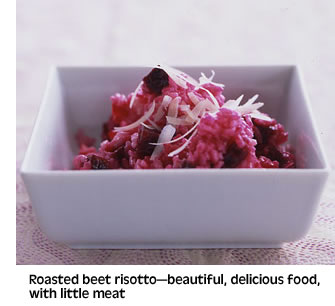
Limitations
- Introduction
- Avoiding the Obvious
- Insoluble Problems, Soluble Opportunities
- Bottomless Wells?
- Oil, Peaking?
Values
- Introduction
- Trouble with Ideology
- The Good Life
- Changing Separately and Together
- Eating for the Planet
- Small Steps, Large Ideals
- Offsetting Without Tears
Design
- Introduction
- Dead Spaces
- Requiem for the Car Industry
- Smart Cars, Hybrids, and Our Spaceship
- Hip Deep in the Big Muddy
- The Virtues of Age
- Two Suburbs—An American Journey
- The Wasteland at the End of the Street
Strategy
![]()
Eating for the Planet
 In 1971, Frances Moore Lappe's Diet for a Small Planet argued that modern agribusiness practices and the Western meat-centered diet were wasteful and impractical in a world with a growing population. Lappe has since modified some of her dietary theories and begun to emphasize inequities in the food distribution system as a major cause of hunger. But one central assumption of the book still stands—more firmly now than in 1971: Our methods of food production and distribution and our diet preferences have major effects on the environment.
In 1971, Frances Moore Lappe's Diet for a Small Planet argued that modern agribusiness practices and the Western meat-centered diet were wasteful and impractical in a world with a growing population. Lappe has since modified some of her dietary theories and begun to emphasize inequities in the food distribution system as a major cause of hunger. But one central assumption of the book still stands—more firmly now than in 1971: Our methods of food production and distribution and our diet preferences have major effects on the environment.
Thirty-five years later, the questions are different. Hunger remains an issue, but we now know that our food production and distribution are major contributors to the increase in greenhouse gases. Livestock—chiefly beef and dairy cattle, but other livestock as well—account for around 18% of greenhouse gas emissions worldwide, according to the Livestock, Environment and Development Initiative (LEAD). This figure includes the effects of deforestation to raise livestock, transportation, production of feed, and gas created by the animals themselves.
LEAD suggests that better farming methods and better animal feeds could mitigate many of the problems created by livestock. But greenhouse gases from livestock are only part of a larger problem in the developed world: the production and distribution of food itself. In the United States, much of our produce comes from California and Florida, usually by truck, at enormous cost to the environment. Much of it is nourished by artificial fertilizers, produced and transported at enormous cost to the environment.
Some of this would be hard to avoid even in an ideal world. Staple grains will not grow everywhere, for example, and need to be transported somehow from the places where they will grow to the places where they will be eaten. But, even in the era of sprawl, the United States still has a lot of good farmland where livestock could be raised more humanely and less destructively than at present—and where both livestock and produce could be farmed nearer to where consumers live.
Raising livestock and produce more naturally and locally would not only benefit the environment. It would have health and taste benefits as well. Naturally-produced hamburger, for example, is more expensive than the standard McDonald's variety. But it is less likely to give you e coli infection or mad cow disease, and it tastes better than the bland stuff that passes for beef in fast food restaurants. Local produce almost always tastes better than produce from across the country because it is fresher. And it is likely to be more nutritious, again because it is fresher.
It is easy to see that if we ate less meat and more vegetables—as the U.S. government itself has recommended—we and the environment would be healthier. What is not so obvious is that we would also be eating more enjoyably and more traditionally. The great cuisines of the world—French, Chinese, Italian, and hundreds of others—have never centered around 16-ounce servings of beefsteak. They are not vegetarian, but by using fresh ingredients and cooking them with care, they can produce delicious and healthful meals using far less meat than is standard on American tables. Huge servings of meat are not even traditional in the U.S. Many of our classic dishes, like Boston baked beans, were designed to stretch meat when it was a rare and expensive commodity. Some, like macaroni and cheese, contain no meat at all.
Healthy, delicious, and good for the environment—a combination that is hard to beat when talking about food. Those who look for good ingredients and cook them with respect will never miss McDonald's. They may even wonder why they ate there in the first place.